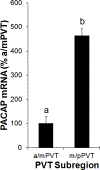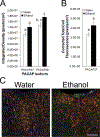Pituitary Adenylate Cyclase-Activating Polypeptide-27 (PACAP-27) in the Thalamic Paraventricular Nucleus Is Stimulated by Ethanol Drinking
- PMID: 29969146
- PMCID: PMC6120804
- DOI: 10.1111/acer.13826
Pituitary Adenylate Cyclase-Activating Polypeptide-27 (PACAP-27) in the Thalamic Paraventricular Nucleus Is Stimulated by Ethanol Drinking
Abstract
Background: The paraventricular nucleus of the thalamus (PVT) is a limbic brain structure that affects ethanol (EtOH) drinking, but the neurochemicals transcribed in this nucleus that may participate in this behavior have yet to be fully characterized. The neuropeptide, pituitary adenylate cyclase-activating polypeptide (PACAP), is known to be transcribed in other limbic areas and to be involved in many of the same behaviors as the PVT itself, possibly including EtOH drinking. It exists in 2 isoforms, PACAP-38 and PACAP-27, with the former expressed at higher levels in most brain regions. The purpose of this study was to characterize PACAP in the PVT and to assess its response to EtOH drinking.
Methods: First, EtOH-naïve, Sprague Dawley rats were examined using quantitative real-time polymerase chain reaction (qPCR) and immunohistochemistry, to characterize PACAP mRNA and peptide throughout the rostrocaudal axis of the PVT. Next, EtOH-naïve, vGLUT2-GFP transgenic mice were examined using immunohistochemistry, to identify the neurochemical phenotype of the PACAPergic cells in the PVT. Finally, Long Evans rats were trained to drink 20% EtOH under the intermittent-access paradigm and then examined with PCR and immunohistochemistry, to determine the effects of EtOH on endogenous PACAP in the PVT.
Results: Gene expression of PACAP was detected across the entire PVT, denser in the posterior than the anterior portion of this nucleus. The protein isoform, PACAP-27, was present in a high percentage of cell bodies in the PVT, again particularly in the posterior portion, while PACAP-38 was instead dense in fibers. All PACAP-27+ cells colabeled with glutamate, which itself was identified in the majority of PVT cells. EtOH drinking led to an increase in PACAP gene expression and in levels of PACAP-27 in individual cells of the PVT.
Conclusions: This study characterizes the PVT neuropeptide, PACAP, and its understudied protein isoform, PACAP-27, and demonstrates that it is involved in pharmacologically relevant EtOH drinking. This indicates that PACAP-27 should be further investigated for its possible role in EtOH drinking.
Keywords: Anterior Paraventricular Nucleus of the Thalamus; Intermittent Access; PACAP-38; Pituitary Adenylate Cyclase-Activating Polypeptide; Posterior Paraventricular Nucleus of the Thalamus.
© 2018 by the Research Society on Alcoholism.
Figures






Similar articles
-
Pituitary adenylate cyclase-activating polypeptide (PACAP)overexpression in the paraventricular nucleus of the thalamus alters motivated and affective behavior in female rats.Alcohol Clin Exp Res (Hoboken). 2025 Mar;49(3):539-550. doi: 10.1111/acer.15525. Epub 2025 Jan 2. Alcohol Clin Exp Res (Hoboken). 2025. PMID: 39746847
-
Pituitary adenylate cyclase-activating polypeptide (PACAP)+ cells in the paraventricular nucleus of the thalamus: relationship with binge-type eating in male and female mice.Psychopharmacology (Berl). 2025 Feb;242(2):413-426. doi: 10.1007/s00213-024-06692-9. Epub 2024 Sep 28. Psychopharmacology (Berl). 2025. PMID: 39340653 Free PMC article.
-
Sex-related differences in endogenous pituitary adenylate cyclase-activating polypeptide (PACAP) in the thalamic paraventricular nucleus: Implications for addiction neuroscience.Addict Neurosci. 2023 Mar;5:100058. doi: 10.1016/j.addicn.2022.100058. Epub 2022 Dec 16. Addict Neurosci. 2023. PMID: 36798694 Free PMC article.
-
Pleiotropic pituitary adenylate cyclase-activating polypeptide (PACAP): Novel insights into the role of PACAP in eating and drug intake.Brain Res. 2020 Feb 15;1729:146626. doi: 10.1016/j.brainres.2019.146626. Epub 2019 Dec 26. Brain Res. 2020. PMID: 31883848 Free PMC article. Review.
-
Expression and Distribution of Neuropeptide-Expressing Cells Throughout the Rodent Paraventricular Nucleus of the Thalamus.Front Behav Neurosci. 2021 Jan 14;14:634163. doi: 10.3389/fnbeh.2020.634163. eCollection 2020. Front Behav Neurosci. 2021. PMID: 33584216 Free PMC article. Review.
Cited by
-
Heightened Exploratory Behavior Following Chronic Excessive Ethanol Drinking: Mediation by Neurotensin Receptor Type 2 in the Anterior Paraventricular Thalamus.Alcohol Clin Exp Res. 2020 Sep;44(9):1747-1759. doi: 10.1111/acer.14406. Epub 2020 Jul 26. Alcohol Clin Exp Res. 2020. PMID: 32623746 Free PMC article.
-
Inactivation of the thalamic paraventricular nucleus promotes place preference and sucrose seeking in male rats.Psychopharmacology (Berl). 2022 Aug;239(8):2659-2671. doi: 10.1007/s00213-022-06160-2. Epub 2022 May 7. Psychopharmacology (Berl). 2022. PMID: 35524009 Free PMC article.
-
Emerging pharmacological targets for alcohol use disorder.Alcohol. 2024 Dec;121:103-114. doi: 10.1016/j.alcohol.2024.07.007. Epub 2024 Jul 26. Alcohol. 2024. PMID: 39069210 Review.
-
Pituitary adenylate cyclase-activating polypeptide (PACAP) modulates dependence-induced alcohol drinking and anxiety-like behavior in male rats.Neuropsychopharmacology. 2021 Feb;46(3):509-518. doi: 10.1038/s41386-020-00904-4. Epub 2020 Nov 16. Neuropsychopharmacology. 2021. PMID: 33191400 Free PMC article.
-
Pituitary adenylate cyclase-activating polypeptide (PACAP)overexpression in the paraventricular nucleus of the thalamus alters motivated and affective behavior in female rats.Alcohol Clin Exp Res (Hoboken). 2025 Mar;49(3):539-550. doi: 10.1111/acer.15525. Epub 2025 Jan 2. Alcohol Clin Exp Res (Hoboken). 2025. PMID: 39746847
References
-
- Ahnaou A, Yon L, Arluison M, Vaudry H, Hannibal J, Hamon M, Adrien J & Bourgin P (2006) Immunocytochemical distribution of VIP and PACAP in the rat brain stem: implications for REM sleep physiology. Ann N Y Acad Sci, 1070, 135–142. - PubMed
-
- Arluison M, Brochier G, Vankova M, Leviel V, Villalobos J & Tramu G (1994) Demonstration of peptidergic afferents to the bed nucleus of the stria terminalis using local injections of colchicine. A combined immunohistochemical and retrograde tracing study. Brain Res Bull, 34, 319–337. - PubMed
Publication types
MeSH terms
Substances
Grants and funding
LinkOut - more resources
Full Text Sources
Other Literature Sources
Medical

